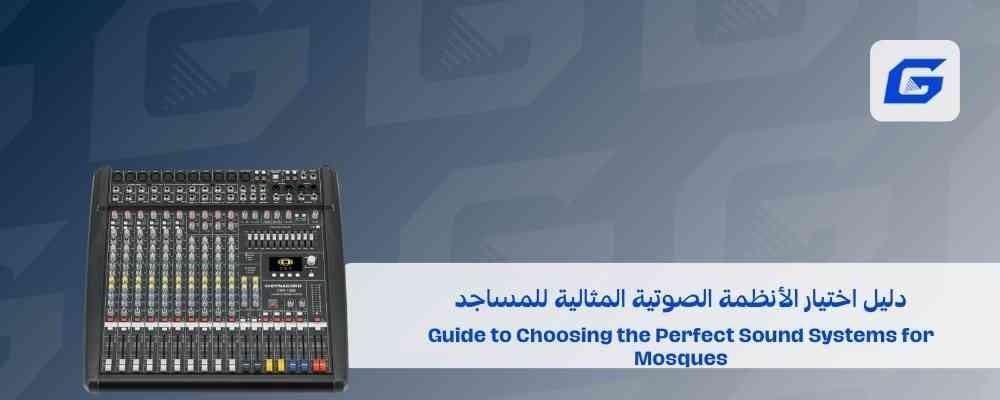Sound systems in mosques are essential components that enhance the worshipers’ experience and help deliver sound clearly and accurately during prayers and sermons. Choosing the right sound system for a mosque depends on several factors, such as the size of the mosque, the type of materials used in its construction, and the number of worshipers. In this article, we will learn about the most important tips and criteria for choosing the ideal sound systems for mosques.
1. The importance of sound systems in mosques
Sound systems in mosques contribute to:
- Delivering the imam’s voice clearly to all worshippers, whether inside or outside the mosque.
- Improving the worshippers’ experience during prayers, especially in large mosques or those with multiple sections.
- Enhance spiritual impact with clear and pure sound.
2. Choosing the right speakers
Types of loudspeakers used in mosques:
- Wall speakers:
- It is installed on interior and exterior walls.
- Provides good sound coverage without requiring large spaces.
- Suitable for mosques with high ceilings.
- Provides even sound distribution in all directions.
- It is used to transmit sound to the surrounding areas of the mosque during prayer or the call to prayer.
Speaker selection criteria:
- Performance Power: Speakers should be able to cover all spaces clearly.
- Sound clarity: Choose speakers that reduce distortion and maintain sound quality.
- Environmental resistance: In open mosques or those that require outdoor speakers, the speakers must be resistant to water and dust.
3. Types of microphones suitable for mosques
Wired microphones:
- They are commonly used for their stability and high sound quality.
- Suitable for Friday sermons and the call to prayer.
Wireless microphones:
- It provides greater flexibility for the imam to move freely inside the mosque.
- Ideal for events and lectures that require movement.
Head microphones:
- Used to deliver clear and direct sound.
- Reduces ambient noise.
4. Sound distribution inside the mosque
Even sound distribution within the mosque is crucial to ensure that all worshippers hear the imam clearly.
Best ways to distribute sound:
- Use multiple speakers evenly distributed on the walls or ceiling.
- Consider the height of the speakers to avoid sound reflection or bounce.
- Tuning the sound system using a digital sound processor (DSP) to distribute the sound and adjust the frequencies according to the size of the mosque and its acoustic characteristics.
5. Echo processing and sound enhancement
In mosques with high ceilings and solid walls, echo can be a problem that affects the clarity of sound.
Echo processing methods:
- Installing soundproof panels on walls and ceilings.
- Use directional speakers to reduce sound reflection.
- Adjusting frequencies using audio processing units .
6. Environmental factors affecting vocal systems
Inside the mosque:
- Using thick carpets reduces sound reflection and improves sound quality.
- The design of walls and ceilings affects the distribution of sound.
Outside the mosque:
- Choose weather-resistant speakers to deliver sound clearly to surrounding areas.
7. Tips for installing and maintaining sound systems
- Install speakers and microphones in strategic locations to ensure optimal coverage.
- Use expandable sound systems to accommodate any future changes in mosque size or number of worshippers.
- Perform regular checks to ensure that all equipment is operating efficiently.
- Training a specialized team to adjust the audio system and deal with any malfunctions.
8. Modern technologies in mosque audio systems
- Wireless audio systems: allow flexibility in installation and control.
- Remote Control: Allows you to easily adjust sound settings.
- Digital sound processing systems: Greatly improve sound quality by adjusting frequencies and removing noise.
conclusion
Choosing the ideal sound system for mosques requires understanding the needs of the place and ensuring that advanced technologies are used to ensure clear and pure sound. By choosing high-quality speakers , advanced microphones , and sound distribution and processing technologies, the worshiper experience can be greatly improved and the acoustic environment can be made more spiritual and comfortable.
Post Cover Description
Cover showing a modern mosque with built-in sound systems , showing wall and ceiling speakers inside the mosque, with side shots showing the imam's microphone during the call to prayer and Friday sermon, and an exterior view highlighting the external speakers transmitting the call to prayer to the surroundings.

